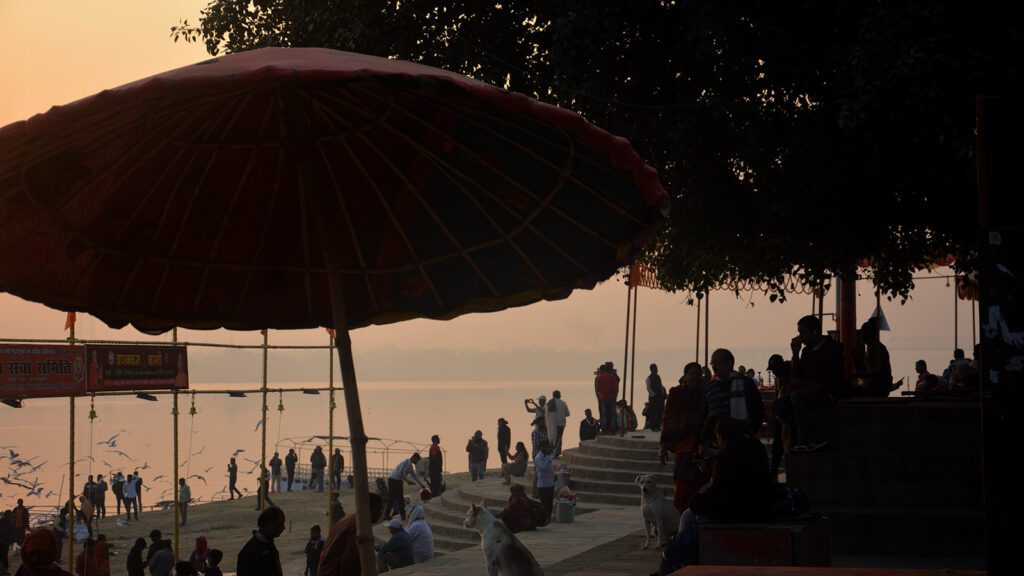A Chance Stop, Not a Planned Visit
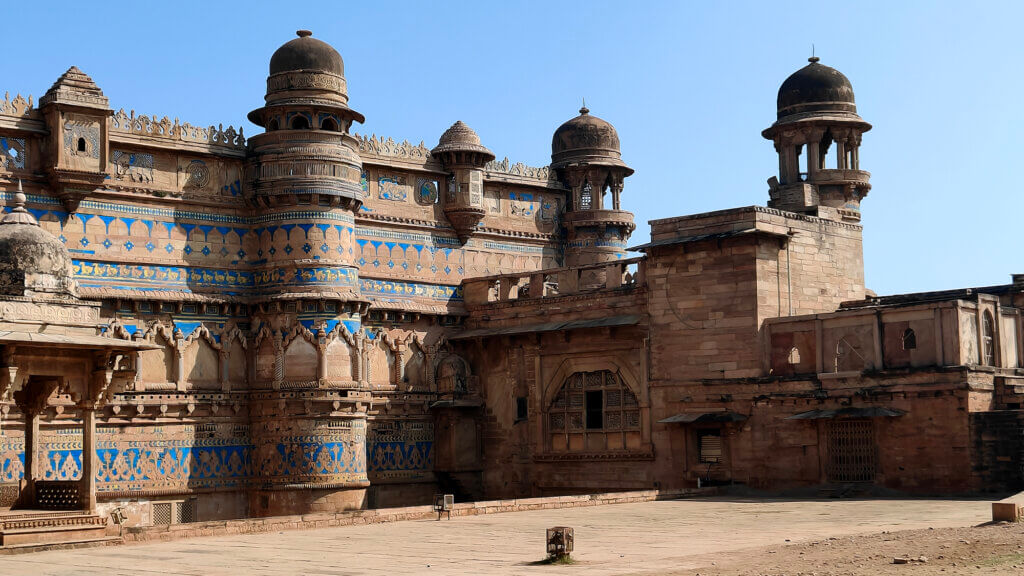
I reached Gwalior almost by chance — to spend a day between two activities. Normally, I study the background of any historical or cultural site I plan to visit. But this time, I didn’t do that. One of my dear friends had mentioned that the city and the gwalior fort weren’t very interesting, which made me even less inclined to do research. I entered Gwalior feeling neutral, more excited about staying at an 18th-century property of a Maratha Sardar that had been converted into a luxury stay than about visiting the fort itself.
 As we arrived at our stay in the evening, we were mesmerized by a group of peacocks wandering through the property. Surrounded by an ancient temple, a puja grih, chhatris, and a restaurant housed in a historical structure, the place was set in the midst of vast green space. This tranquil setting was the perfect mood for the next day’s exploration of the city, known mainly for its fort.
As we arrived at our stay in the evening, we were mesmerized by a group of peacocks wandering through the property. Surrounded by an ancient temple, a puja grih, chhatris, and a restaurant housed in a historical structure, the place was set in the midst of vast green space. This tranquil setting was the perfect mood for the next day’s exploration of the city, known mainly for its fort.
Climbing Towards the Gwalior Fort Top and Discovering Centuries
We entered the Gwalior fort from Urvai gate in the south. The road from here climbs steeply to the hilltop — long and meandering, it passes the famous 12th-century Jain caves and carvings, known for their scale and beauty.
 We soon reached the hilltop. The Gwalior fort is spread over 3 square kilometres. The most amazing of all the buildings which were built over the last 15 centuries and are scattered all over the hilltop, greeted us with its mesmerising blue tile work on sandstone. The turrets with 3D carvings and extensive inlay of blue tiles — including depictions of animals and, in one case, ducks marching in a line — and other motifs adorned the palace walls, connecting the ground to the sky above.
We soon reached the hilltop. The Gwalior fort is spread over 3 square kilometres. The most amazing of all the buildings which were built over the last 15 centuries and are scattered all over the hilltop, greeted us with its mesmerising blue tile work on sandstone. The turrets with 3D carvings and extensive inlay of blue tiles — including depictions of animals and, in one case, ducks marching in a line — and other motifs adorned the palace walls, connecting the ground to the sky above.
We were taken aback by the beauty of the Man Mandir Palace and were truly mesmerised.
 The knowledgeable guide told us about the incredible and long history of Gwalior fort. It has been ruled by many — from the Guptas to the Scindias — each contributing to its growth.
The knowledgeable guide told us about the incredible and long history of Gwalior fort. It has been ruled by many — from the Guptas to the Scindias — each contributing to its growth.
Founded by Suraj Sen in the 7th century, the Gwalior fort draws its name from a hermit called Gwalipa, who is said to have cured Suraj Sen’s leprosy — on the condition that the fort be named after him.
Structures from the 6th century to the 18th century are strewn all over the Gwalior fort, built by various dynasties- pratiharas, Kacchapas, Tomars, Suris, Mughals, Jats, British and Scindia among them- in evolving architectural styles. From rock carvings of the 7th and 12th centuries, temples of the 8th to 11th centuries, to palaces from the 15th and 16th centuries — Man Mandir, Vikram, and Karn palaces — and Mughal additions like Jahangir and Shah Jahan palaces, the fort holds them all. There’s even a British weapons factory built later on the hilltop.
I was bowled over by the historical and cultural significance of the place and was keen to explore everything it had to offer.
The Medley of Blue Tiles and Pink Stone
 Man Mandir Palace, the most marvellous and celebrated structure, was built by Raja Man Singh Tomar of the Tomar dynasty in the late 15th century — mostly in a Hindu style, with minimal Islamic influences. It has four levels — two above ground and two below — with two beautiful courtyards. The blue tile work on the sandstone complements the vast blue sky above. In these courtyards, the pink stone and blue tiles create an exquisite medley.
Man Mandir Palace, the most marvellous and celebrated structure, was built by Raja Man Singh Tomar of the Tomar dynasty in the late 15th century — mostly in a Hindu style, with minimal Islamic influences. It has four levels — two above ground and two below — with two beautiful courtyards. The blue tile work on the sandstone complements the vast blue sky above. In these courtyards, the pink stone and blue tiles create an exquisite medley.
As we approached the Queen’s chambers, which were later turned into a prison by Aurangzeb, an unmistakable air of privacy settled in.  The brilliant way by which the stairs descended to the lower stories — taking both the climber and the sunlight below to light the chambers — was enchanting. The private baths, the sound-conducting niches, and the reflected light made this place magical. The lower chambers are lit by cleverly designed openings on the fort walls that from where one can also see the city below.
The brilliant way by which the stairs descended to the lower stories — taking both the climber and the sunlight below to light the chambers — was enchanting. The private baths, the sound-conducting niches, and the reflected light made this place magical. The lower chambers are lit by cleverly designed openings on the fort walls that from where one can also see the city below.
We then moved to Karn and Vikram Palaces. Karn Palace had a brilliant system of hammam or spa for royalty. The ground in front of it offered a beautiful view of the city and mountains beyond.
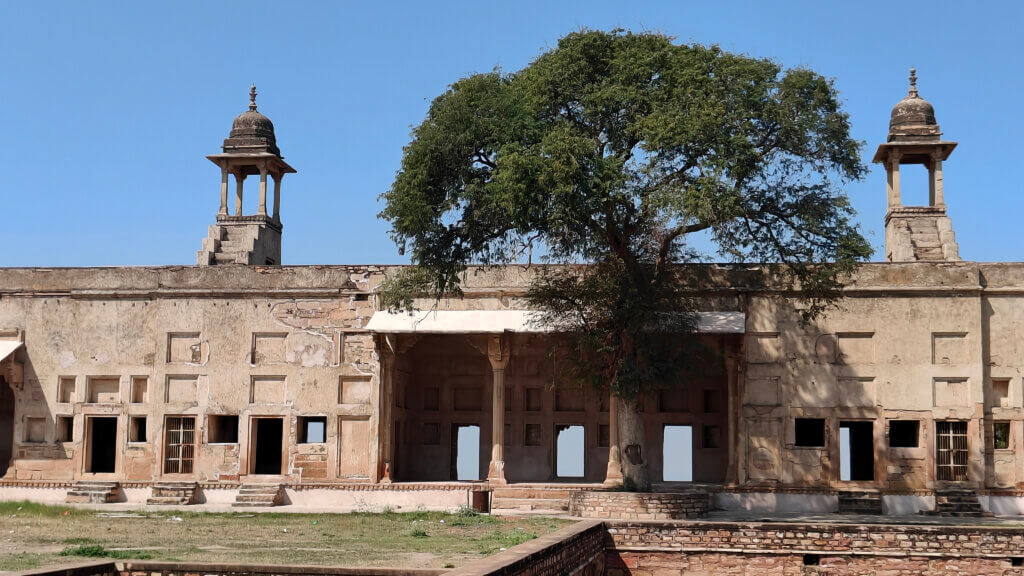
Surprisingly, though the Jahangir and Shah Jahan palaces were grand in scale, they lacked the artistic taste usually associated with these Mughal art-lovers.
Temples, Tales, and Forgotten Inscriptions
While returning, we visited Assi Khamba Bawdi, built by Man Singh. The adjoining structure was a Shiv temple, later used by Jahangir to imprison young Sikh Guru Hargobind Singh. In memory of his release of 52 kings along with himself, a gurudwara now stands at on the hill top.
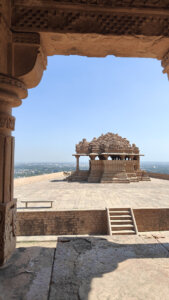 An interesting structure of Sahastrabahu Temple, locally called Saas Bahu Temple —was visible from Shah Jahan Palace. The local deformed name comes from the fact that there are two temples: the larger one dedicated to Lord Vishnu and a smaller pavilion-like one overlooking the city. This 11th-century temple, almost contemporary to Khajuraho, differs from them in style. The scale of the sabhamandap is huge, and I was blown away by its unusual height for a temple of its time. Light filters through a grid of stone elements, and the pavilion is positioned perfectly to observe the city.
An interesting structure of Sahastrabahu Temple, locally called Saas Bahu Temple —was visible from Shah Jahan Palace. The local deformed name comes from the fact that there are two temples: the larger one dedicated to Lord Vishnu and a smaller pavilion-like one overlooking the city. This 11th-century temple, almost contemporary to Khajuraho, differs from them in style. The scale of the sabhamandap is huge, and I was blown away by its unusual height for a temple of its time. Light filters through a grid of stone elements, and the pavilion is positioned perfectly to observe the city.
We didn’t want to leave, enjoying the cool breeze and panoramic views of the city from Gwalior fort. Next we visited the 9th-century Teli Ka Mandir — the tallest and most magnificent temple in the fort complex. One of its kind, it combines a Dravidian square-shaped shikhara with Nagara-style decorations. Dedicated to Vishnu, it was built by the Pratihara king Mihir Bhoja and later restored during British times.
 As our auto dropped us back at Man Singh Palace, we exited from Hathi Pol — the strategically placed elephant gate. Along the way, there were many caves carved into the fort wall, and at times, even massive sculptures. We also stopped by Chaturbhuj Mandir, commonly known as the Zero Temple. Built in the 9th century, this small but significant temple contains the second-oldest known inscription of the number zero. As a lover of mathematics, I always take pride in the fact that India gave zero to the world, making the world of mathematics and science easier to explore. This encounter filled me with excitement and awe—a rare moment where historical legacy met personal passion in the most unexpected way.
As our auto dropped us back at Man Singh Palace, we exited from Hathi Pol — the strategically placed elephant gate. Along the way, there were many caves carved into the fort wall, and at times, even massive sculptures. We also stopped by Chaturbhuj Mandir, commonly known as the Zero Temple. Built in the 9th century, this small but significant temple contains the second-oldest known inscription of the number zero. As a lover of mathematics, I always take pride in the fact that India gave zero to the world, making the world of mathematics and science easier to explore. This encounter filled me with excitement and awe—a rare moment where historical legacy met personal passion in the most unexpected way.
Of Love Stories and Museum Treasures
Before exiting the Kila Gate, we visited Gurjari Mahal, the palace of the queen from Gurjar community—also called Mrignayani in folklore.  Enamoured by her beauty and bravery, Raja Man Singh wanted to marry this fierce girl who was brought up in humble surroundings and belonging to a lower caste.
Enamoured by her beauty and bravery, Raja Man Singh wanted to marry this fierce girl who was brought up in humble surroundings and belonging to a lower caste.
Mrignayani had only two conditions: she would not live with the high-caste queens- she must have her own palace and she would also drink water only from her village—around 20 kilometres away. Much in love, the king fulfilled all the conditions. Gurjari Mahal lies at the foothills of the fort. Plumbing pipelines from the village to the palace can still be seen in the basement of what is now an archaeological museum.
 As I moved around appreciating the sculptures and artefacts from the region, belonging to the ancient era. I was overcome with emotion, knowing how diverse, varied, and rich our history and culture are.
As I moved around appreciating the sculptures and artefacts from the region, belonging to the ancient era. I was overcome with emotion, knowing how diverse, varied, and rich our history and culture are.
Every part of this great land holds jewels waiting to be discovered by seekers. Gwalior Fort, one of the oldest defensive forts in India, is among the brightest of these jewels. I’m glad I visited this place of such historical significance.
A Fort Worth Getting Lost In
But Gwalior fort is not just for lovers of history — it’s for anyone who loves beauty carved in stone, who loves the breeze on the mountaintops, who wants to observe the city from the hills, and most of all — it is for anyone who wants to get sucked into the labyrinth of the fort and get lost.
 Reflecting on the visit, I can confidently say that Gwalior fort wasn’t just another stop on my journey—it was an unexpected revelation. Without the burden of expectations, I was able to immerse myself fully in the fort’s grandeur and history. The fort, with its beauty, stories, and cultural treasures, offered a fresh perspective on both history and personal discovery. Sometimes, it’s best to walk into the unknown without preparation and let the place reveal its wonders. Gwalior didn’t just add to my list of destinations; it gave me a deeper appreciation for India’s rich heritage.
Reflecting on the visit, I can confidently say that Gwalior fort wasn’t just another stop on my journey—it was an unexpected revelation. Without the burden of expectations, I was able to immerse myself fully in the fort’s grandeur and history. The fort, with its beauty, stories, and cultural treasures, offered a fresh perspective on both history and personal discovery. Sometimes, it’s best to walk into the unknown without preparation and let the place reveal its wonders. Gwalior didn’t just add to my list of destinations; it gave me a deeper appreciation for India’s rich heritage.
Must-Visit Places in and Around Gwalior Fort
-
Man Singh Palace (Man Mandir Palace)
-
Gopachal Jain Parvat
-
Sahastrabahu Temple and Pavilion (Saas Bahu Temple)
-
Teli Ka Mandir
-
Bandi Chhor Gurudwara
-
Other Palaces
-
Assi Khambha Bawdi
-
Chaturbhuj Mandir (Zero Temple)
-
Gates
-
Gurjari Mahal
-
Jai Vilas Palace
-
Jhansi Rani Memorial
-
Tomb of Tansen
Gallery
Man Singh Palace (Man Mandir Palace)
Built by Raja Man Singh Tomar between 1486–1516 CE), the Man Mandir Palace stands as the crowning glory of Gwalior Fort. Commissioned by Raja Man Singh Tomar in the late 15th century, it was designed not merely as a stronghold but as a symbol of opulence and refined taste. The palace served primarily as a residential complex for the royal family and was a vibrant center of music, dance, and courtly life during Man Singh’s reign. After the fall of the Tomars, it was repurposed by successive rulers — notably the Mughals, who used it as a prison. Some tragic tales, like that of Murad, son of Shah Jahan, being executed here, add layers of melancholy to its otherwise festive history.
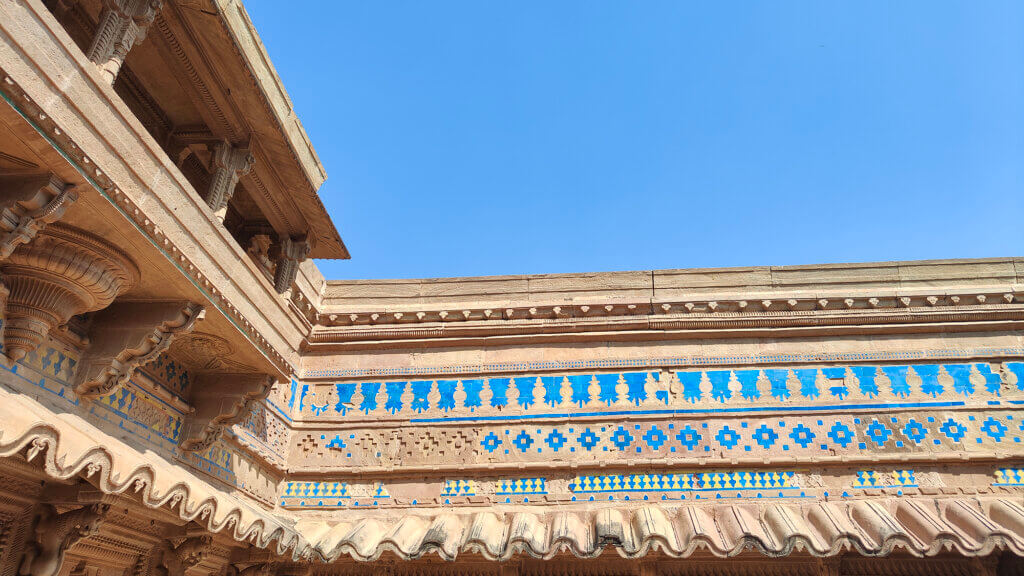
The palace is famed for its breathtaking facade, adorned with vibrant blue, yellow, and green ceramic tiles forming intricate motifs of ducks, crocodiles, and floral patterns — a rare decorative style in medieval Indian architecture. Its thick defensive walls hide beautiful inner courtyards, intricate stone jaalis (latticed screens), underground escape routes, and secret chambers designed for surveillance and communication. The acoustics in the underground rooms are said to be so finely tuned that a whisper from one corner carries clearly to another.
Man Mandir Palace is a rare surviving example of Rajput palace architecture prior to the full dominance of Mughal style in North India. It showcases the artistic sophistication and cultural richness that once flourished in Gwalior, bridging the world of military defense with royal elegance.
Gopachal Jain Parvat
Carved directly into the cliffside leading up to the fort, the Gopachal Jain Parvat is a stunning collection of 12th to 15th-century colossal Jain sculptures, some over 50 feet tall. These rock-cut images of the Jain Tirthankaras were commissioned mainly during the Tomar period and reflect the patronage Gwalior extended to Jainism. The serene expressions of the sculptures, combined with their massive scale, make them awe-inspiring. Located along the Urvai Gate climb, these masterpieces highlight Gwalior’s rich religious tolerance and artistic achievements.
Sahastrabahu Temple and Pavilion (Saas Bahu Temple)

Located near the eastern side of the fort complex, the Sahastrabahu Temple (often mispronounced as Saas Bahu Temple) dates back to the late 11th century, built during the reign of King Mahipala of the Kachchhapaghata dynasty. Despite the name, the temple is dedicated to Vishnu, with its name ‘Sahastrabahu’ meaning ‘the one with a thousand arms.’ The complex features two temples — a larger one and a smaller pavilion — both displaying exquisite carvings and an unusually high sabhamandap (assembly hall). Light filters through intricate stone lattice work, offering stunning views of the city below. The temple’s architecture shows a unique regional deviation from the better-known Khajuraho style.
Teli Ka Mandir
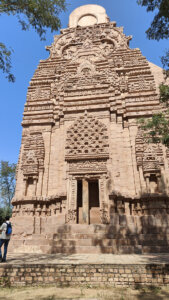
Teli Ka Mandir, located inside the fort complex, is the tallest structure within the fort, standing at 100 feet. Built around the 9th century CE under the reign of the Pratihara dynasty, particularly King Mihir Bhoja, the temple is a fascinating fusion of Dravidian and Nagara architectural styles. Its towering shikhara is Dravidian in form but richly decorated with typical North Indian motifs. Originally dedicated to Vishnu, the temple’s sheer scale and unique design set it apart from other temples of the period, symbolizing the cosmopolitan influences that Gwalior absorbed.
Bandi Chhor Gurudwara
Perched near Assi Khambha Bawdi within the fort, Bandi Chhor Gurudwara commemorates Guru Hargobind Singh’s release from imprisonment here by Mughal Emperor Jahangir in the early 17th century. Not only did the Guru secure his own freedom, but he also ensured the release of 52 imprisoned kings, earning the title ‘Bandi Chhor’ (Liberator of Prisoners). The gurudwara is a small but deeply spiritual site.
Karn Palace and Vikram Palace
Adjacent to Man Mandir Palace, the Karn and Vikram Palaces were built slightly later during the Tomar rule, likely intended for royal use by younger generations or auxiliary functions. Though less elaborately decorated than Man Mandir, Karn Palace impresses with its royal hammam (bath system) and commanding views of the city and the hills beyond. Vikram Palace, with its interconnected corridors and simpler layout, hints at a more functional design, serving as residential quarters within the sprawling royal complex.
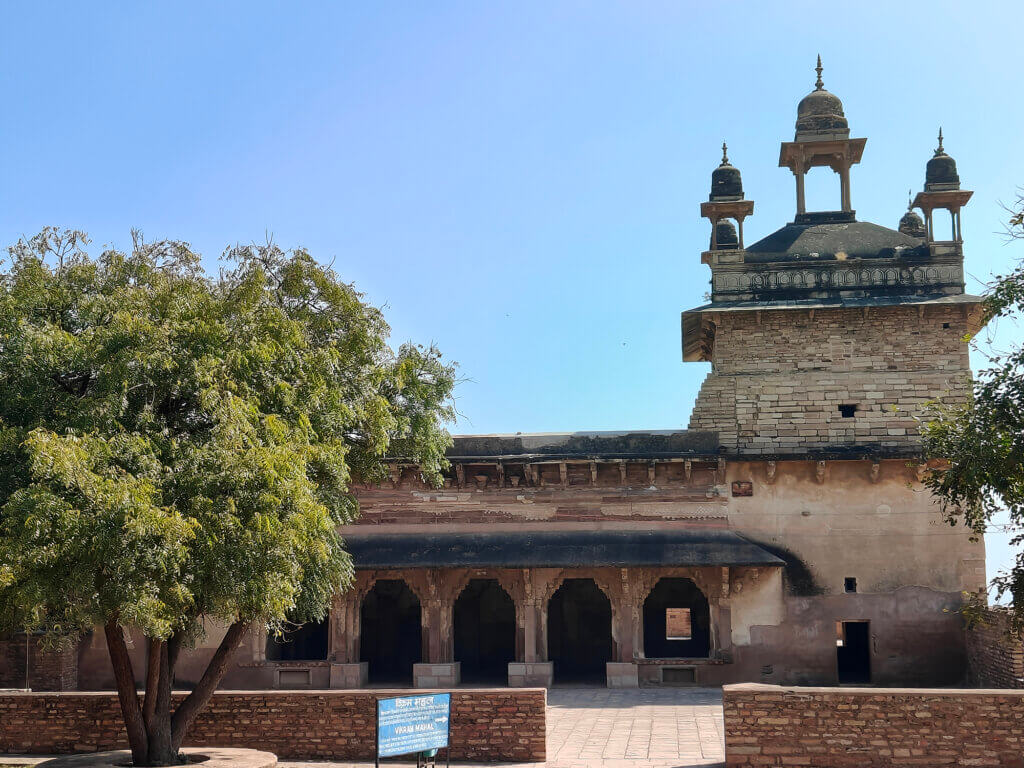
Shah Jahan and Jahangir Palaces
Built during the Mughal era, these palaces — located on the southern side of the fort — reflect the grandeur but also the evolving utilitarian priorities of the Mughals. Though their scale is imposing, their artistic detailing is relatively subdued compared to Mughal constructions elsewhere, suggesting Gwalior was more of a strategic military post during their reign. Still, wandering through these halls evokes the period when Gwalior was a prized possession of the Mughal Empire.
Assi Khambha Bawdi
 Assi Khambha Bawdi, or the ‘well with 80 pillars,’ was constructed during Raja Man Singh’s time as a source of water supply for the fort. Its robust stone construction and sheer scale highlight the engineering prowess needed to sustain life atop the rocky outcrop of Gwalior. Adjacent to this baoli is the temple where Guru Hargobind Singh was imprisoned, adding layers of history to the site.
Assi Khambha Bawdi, or the ‘well with 80 pillars,’ was constructed during Raja Man Singh’s time as a source of water supply for the fort. Its robust stone construction and sheer scale highlight the engineering prowess needed to sustain life atop the rocky outcrop of Gwalior. Adjacent to this baoli is the temple where Guru Hargobind Singh was imprisoned, adding layers of history to the site.
Chaturbhuj Mandir (Zero Temple)

This small but historically significant 9th-century temple near Hathi Pol within the fort is home to one of the earliest known inscriptions using the numeral ‘0’ in India. Built under the rule of the Gurjara-Pratihara dynasty, it’s a modest shrine architecturally but a monumental milestone in mathematical history. For anyone passionate about mathematics or ancient knowledge systems, this temple offers a thrilling connection to India’s scientific legacy.
Hathi Gate (Elephant Gate)
The main ceremonial entrance to the fort, Hathi Gate is so named because it was once wide and tall enough to allow elephants to pass through easily. A strategic gateway, it connects the inner fort with the outer world and stands today as a symbol of Gwalior’s defensive brilliance and regal display.
Killa Gate
Serving as another important entrance/exit for the fort, Killa Gate is less ornamental than Hathi Pol but critical for strategic movement within the fort walls. It was part of the network that helped the fort withstand multiple sieges over the centuries.
Gurjari Mahal and Archaeological Museum

At the base of the fort hill stands Gurjari Mahal, the palace built by Raja Man Singh Tomar for his beloved consort Mrignayani. The story goes that Mrignayani, a Gurjar girl, agreed to marry the king only on the conditions that she would have a separate palace and water from her village. Gurjari Mahal, thus, embodies romance transcending caste divides. Today, it houses an impressive archaeological museum, showcasing sculptures, inscriptions, and artefacts from different eras, providing a perfect closure to Gwalior’s layered past.
Jai Vilas Palace
 Located within the city of Gwalior and not the fort, Jai Vilas Palace was constructed in 1874 by Jayajirao Scindia, the Maharaja of Gwalior. Designed by a British architect in the European style, it boasts one of the largest chandeliers in the world and luxurious interiors modeled after Italian palaces. Though it represents a very different era — colonial opulence rather than medieval valor — it is an essential part of understanding Gwalior’s transition into modern India.
Located within the city of Gwalior and not the fort, Jai Vilas Palace was constructed in 1874 by Jayajirao Scindia, the Maharaja of Gwalior. Designed by a British architect in the European style, it boasts one of the largest chandeliers in the world and luxurious interiors modeled after Italian palaces. Though it represents a very different era — colonial opulence rather than medieval valor — it is an essential part of understanding Gwalior’s transition into modern India.
Jhansi Rani Memorial

Situated within Phoolbagh in Gwalior city, this memorial commemorates the brave warrior queen, Rani Lakshmibai of Jhansi, who died fighting the British forces during the 1857 Rebellion near this spot. Though simple in appearance, the memorial honors the sacrifice of one of India’s greatest freedom fighters and holds a special emotional place in the hearts of many.
Tomb of Tansen
Though I couldn’t visit it myself, the Tomb of Tansen, located near the Gwalior Fort complex in the city, is the resting place of the legendary musician and one of Akbar’s ‘Navaratnas’ (Nine Jewels). This modest Mughal-style tomb is situated in the same garden complex as his guru Muhammad Ghaus’s tomb, and it hosts the annual Tansen Music Festival — keeping alive the deep cultural roots Gwalior has in Hindustani classical music.




